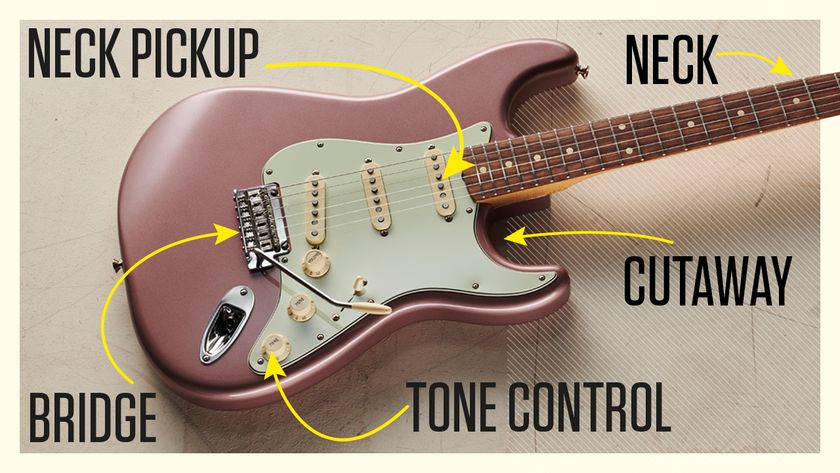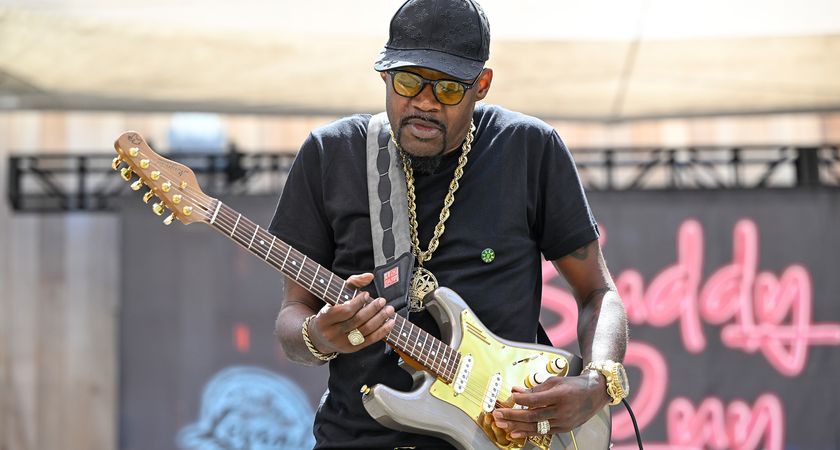The gallop is the most important metal rhythm of them all – learn the breakneck guitar technique behind classic Metallica, Slayer and Iron Maiden riffs
This rhythm found fame in heavy metal, but it's been used in all genres for decades – making it a must-learn for every guitarist

As guitar players, perfecting different types of rhythm is essential, and one particularly demanding example is the gallop. This is a powerful driving rhythm pattern that's widely associated with rock and metal, but which can also be heard in pop and funk. Well-known purveyors of gallop riffs include Iron Maiden, Metallica, Judas Priest, UFO, Dio, Heart, Queen, Black Sabbath, Slayer and many others.
The gallop is a short rhythm created in one beat: an eighth note followed by two 16ths. It's important to understand that although you are playing three subdivisions per beat, the rhythm is not a triplet. The first eighth note lasts as long as the two 16ths combined.
The gallop rhythm should be counted: 1 _ & a 2 _ & a 3 _ & a 4 _ & a
Played with a consistent down-down-up picking motion, the first downstroke lasts for the first half of the beat (1 _), whilst the offbeat is divided into two 16th notes (& a).
A variation of the standard gallop is the reverse gallop, which has been used by bands such as Slayer, Metallica and even the Osmonds! As the name suggests, the reverse gallop changes the rhythmic ordering: two 16th notes followed by a single eighth note.
This reverse gallop should be counted: 1 e & _ 2 e & _ 3 e & _ 4 e & _
This should be performed with a down-up-down picking motion (1 e &).
Both variations of the gallop are demanding because they are precise and repeated, often at fast tempos. Because of this, they are great workouts for your picking hand's accuracy and stamina.
Once you have these two rhythms mastered, experiment with different amounts of palm muting as well as many different tempos. Remember, for maximum 'metal', faster tempos are essential.
Use the full video above in conjunction with the audio and tab/notation shown below.
Tab examples
Example 1. Basic gallop
This example illustrates the gallop in its most basic form, played on an open fifth-string A note. Make sure to count a constant 16th note rhythm (1 e & a, 2 e & a, 3 e & a, 4 e & a), using a foundational alternate picking technique throughout.
The key here is to not pick the 'e' count of the division, but instead perform a ghost pick: an upstroke is made but doesn't make contact with the string (it's 'ghosted').
This regular down-up picking motion will help with counting and performing the rhythm, as well as exiting the initial downstroke and preparing for the next one (on the '&' of each beat).
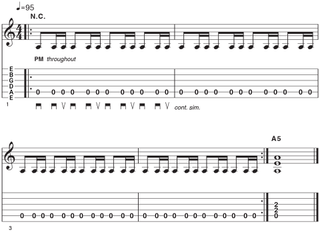
Example 2. Gallop with power chords
Here we put the gallop into a short musical example. For this example you will apply the gallop to two-note power chords.
There are some sustaining Fmaj7add#11 chords to break up the rhythm slightly which add harmonic color as well as give your picking hand a brief rest!
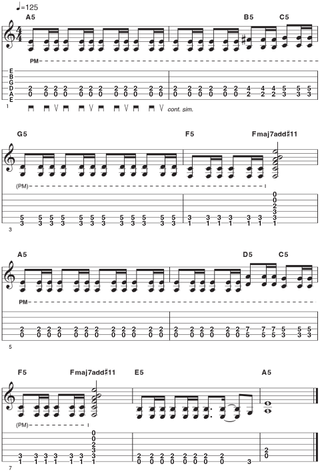
Example 3. Uptempo gallop
For this Iron Maiden-inspired example, the tempo is increased so make sure to keep your picking hand relaxed (you don't want to play with too much tension in the hand or arm).
We've included power chords with their root notes located on the fourth, fifth and sixth strings, so take care with the position of the picking hand.
Enjoy the two-string chord inversions, G/B and D/F#, which act as linking chords in the progression. Add light palm muting for further tightness and a thicker bass tone.
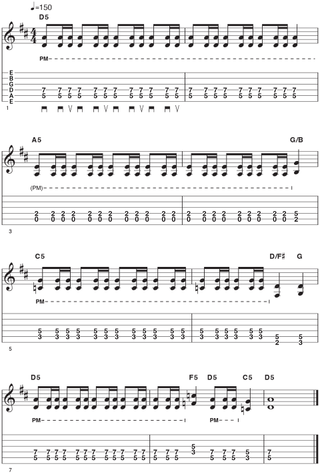
Example 4. Reverse gallop
Taking inspiration here from both The Osmonds and Joe Satriani (check out the riff under his solo on War), this reverse gallop riff uses a single-note line based around the G minor pentatonic scale (G-Bb-C-D-F).
The riff is embellished with power chords as well as a descending pentatonic run to finish off. Be sure to maintain a constant down-up-down picking motion throughout, but follow the final downstroke of each beat with a ghosted up-pick to set you up for the initial downstroke of the following downbeat.
Picking control with the reverse gallop can prove difficult so work on this riff slowly to begin with, focusing on precision and stamina before speed.
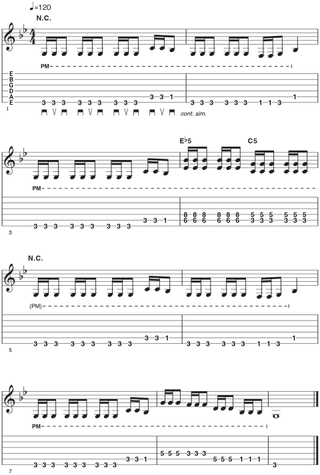
Example 5. Uptempo reverse gallop
This Slayer inspired example shows the reverse gallop as an essential approach for thrash metal. The main focus is the tight reverse gallop played on the sixth string using palm muting.
The riff is enhanced with double stops and single note lines, all of which use notes from the E Locrian mode (E-F-G-A-Bb-C-D).
This riff is demanding, especially when pedalling the tight palm muted sixth string, and accenting with the two string double stop chords. Slow and precise practice will allow you to get this up to speed.
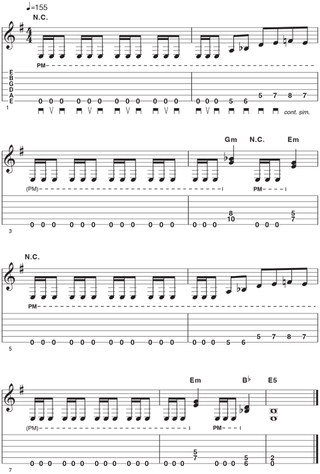
Example 6. Gallop riffs and solo
This final example includes both the gallop and the reverse gallop, with a riff inspired by the likes of Iron Maiden, Slayer, Metallica and UFO.
The first section rounds up the concepts we've looked at so far before concluding with a short solo based around the E minor pentatonic (E-G-A-B-D) and E natural minor scale (E-F#-G-A-B-C-D) played with a reverse gallop.
Once again, this example is at a fast tempo so stay relaxed and practice slowly to start with.
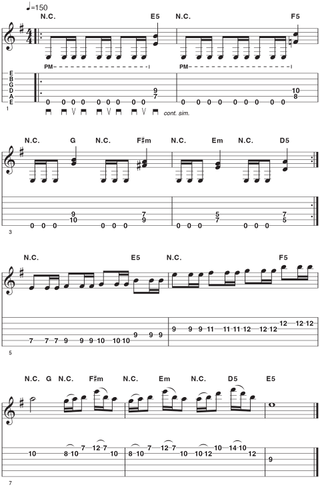
Outstanding examples of the gallop rhythm
Iron Maiden - Run To The Hills
Iron Maiden are well known for their use of the gallop rhythm. Run to the Hills is a great example, with the rhythm not only driving the song but also intensifying the narrative of the lyrical conflict.
Metallica - Battery
The gallop rhythm plays a vital role in creating this song's aggressive feel. It is performed at a very fast tempo with the guitars maintaining a constant tight gallop. The guitar tone is very distorted with a typical scooped tone (midrange EQ is reduced) to enhance the palm muting.
Slayer - Raining Blood
Slayer are probably the most notable purveyors of the reverse gallop and their landmark track Raining Blood made it an essential technique in the thrash genre. The ultra-fast reverse gallop contributes to the song's unrelenting intensity.
Level 42 - Lessons In Love
This is a great example of the gallop being used in an ’80s pop funk context. Using the same rhythm pattern heard in metal, Mark King’s iconic thumb-driven bassline takes on gallop duties. His precision and stamina is impressive.
The Osmonds - Crazy Horses
This '70s classic illustrates a fusing of styles and is a refreshing example of the reverse gallop. Mixing '70s rock with pop, this hit was propelled by the driving reverse gallop guitar and bass riff.
Get The Pick Newsletter
All the latest guitar news, interviews, lessons, reviews, deals and more, direct to your inbox!
Jamie Humphries is an English guitarist based in Sweden. He has toured and performed with artists such as Brian May, Queen, Jeff Beck and Henry Rollins, as well as performing across Europe for We Will Rock You and in America with the Australian Pink Floyd Show. He was a longtime contributor to Guitar Techniques magazine and contributes lessons for Gibson. He runs his own studio in Stockholm where he produces Youtube content for Six String Alliance and Produce Like A Pro. He is a Music Man and Mesa/Boogie endorsee.
You must confirm your public display name before commenting
Please logout and then login again, you will then be prompted to enter your display name.

Marcin’s percussive fingerstyle is dropping jaws with its stunning mix of speed, complexity and explosive dynamics. The warm-ups that fuel his virtuosity are guaranteed to boost your own playing

It’s the flamenco technique that lit the rhythmic fire under Marcin and Paco de Lucía, and treats all four fingers and thumb as separate plectrums – why learning rasgueado will give your picking hand a huge turbo boost









